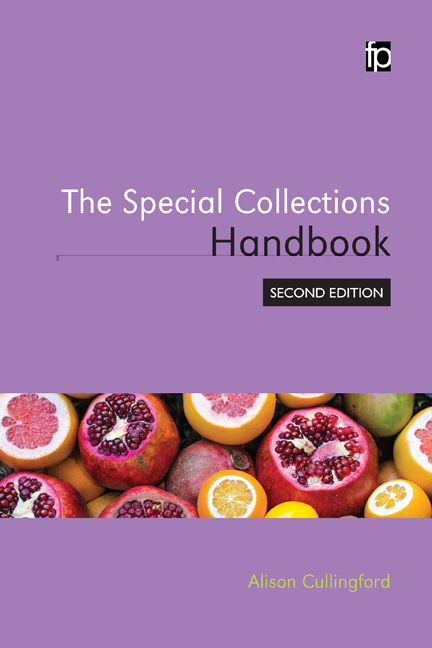Book contents
- Frontmatter
- Contents
- Preface and acknowledgements
- Introduction
- 1 The care of Special Collections
- 2 Emergency planning for Special Collections
- 3 Understanding objects in Special Collections
- 4 Acquiring and developing Special Collections
- 5 Cataloguing, description and metadata in Special Collections
- 6 Digitization and digital libraries in Special Collections
- 7 Legal and ethical issues in Special Collections
- 8 User services in Special Collections
- 9 Marketing and communications in Special Collections
- 10 Widening access to Special Collections
- 11 Organizational resources for Special Collections: space and people
- 12 Influencing and fund-raising for Special Collections
- Afterword: Special Collections futures
- Appendix A The Special Collections reference shelf
- Appendix B Skills for your Special Collections career
- Bibliography
- Index
11 - Organizational resources for Special Collections: space and people
- Frontmatter
- Contents
- Preface and acknowledgements
- Introduction
- 1 The care of Special Collections
- 2 Emergency planning for Special Collections
- 3 Understanding objects in Special Collections
- 4 Acquiring and developing Special Collections
- 5 Cataloguing, description and metadata in Special Collections
- 6 Digitization and digital libraries in Special Collections
- 7 Legal and ethical issues in Special Collections
- 8 User services in Special Collections
- 9 Marketing and communications in Special Collections
- 10 Widening access to Special Collections
- 11 Organizational resources for Special Collections: space and people
- 12 Influencing and fund-raising for Special Collections
- Afterword: Special Collections futures
- Appendix A The Special Collections reference shelf
- Appendix B Skills for your Special Collections career
- Bibliography
- Index
Summary
Introduction
Special Collections need appropriate spaces to house collections, to make them available, and to work on them, plus sufficient staff with the right skills to carry out the activities described in this book. This chapter covers the requirements for Special Collections spaces and people and how to make the most of the resources available to the service.
This chapter covers the key issues to consider in both areas:
Introduction to Special Collections spaces.
Space requirements.
How to improve space with building projects.
How to cope with inadequate spaces.
Introduction to Special Collections staffing.
Staff functions and roles.
Managing in difficult times.
Managing volunteers and interns, and discovering crowd power.
Special Collections functions and their space requirements As explained in Chapter 1, the storage environment is critical in keeping collections safe. Spaces of the right size and nature will also be needed for the other activities outlined in this book. To think effectively about space requirements, it is essential to understand the functions of Special Collections spaces and how they interconnect.
Figure 11.1, a simplified version of a diagram in Kitching (2007) for archives services, shows the key functions and flows in a Special Collections service.
Services may appear much more complex than this diagram, with outstores, exhibitions and other facilities outside their main building, or various branches and buildings. However, the functions represented are common to all Special Collections services.
Note the barrier between public spaces and staff-only spaces. There is also often a barrier between public spaces open to everyone, such as cafés, shops and exhibitions, and reading rooms, which are much more strictly controlled. Such a structure allows a service to welcome the public and generate income from retail, etc., but protects collections by limiting numbers.
The key flows are those of collections and of people (i.e. users and the general public). For security reasons, these flows are kept separate as much as possible except in designated areas: the reading room, exhibition area, learning spaces such as teaching or meeting rooms.
- Type
- Chapter
- Information
- The Special Collections Handbook , pp. 215 - 238Publisher: FacetPrint publication year: 2016



